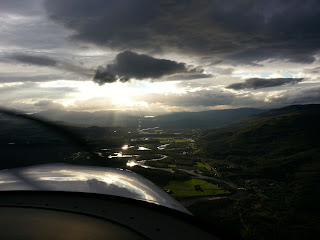Hi!
Winter
came, I guess, but we haven't felt it much here in Ljungbyhed. We had a fair
amount of snowfall one day a few weeks ago, the next day it all rained away and
since that the weather has been way too warm for a proper December.
Anyway, the
MCC, multi crew cooperation course, has progressed smoothly for everybody, as
far as I know. I had my 9th lesson in the simulator the 16th and these last
days before the Christmas break we audit the senior grade students' graduation
thesis presentations. They are obviously all linked to the aviation industry, and
several of them concern human factors, such as cooperation and fatigue. It has
been interesting to listen to them!
So the senior grade, TFHS11, are graduating now after 2½ years of completed training. 11 students completed all basic flight training, all simulator training and theory courses, however 2 of them unfortunately weren't able to complete the final practical stage of line training at the airline. All 9 who have now successfully graduated were also hired by Norwegian, like all students who graduated one year ago. They will work full-time as first officer on the Boeing 737-800 being based separately at Helsinki, London and Malaga.
So the senior grade, TFHS11, are graduating now after 2½ years of completed training. 11 students completed all basic flight training, all simulator training and theory courses, however 2 of them unfortunately weren't able to complete the final practical stage of line training at the airline. All 9 who have now successfully graduated were also hired by Norwegian, like all students who graduated one year ago. They will work full-time as first officer on the Boeing 737-800 being based separately at Helsinki, London and Malaga.
Each
simulator lesson is 4 hours long plus up to one hour each of briefing and
debriefing before and afterwards. We've experienced a lot during the first 36
hours in the simulator, mainly regarding the cooperation between two pilots,
since this is the first occasion for us to practice that. We simulate engine
failure, fire, failure of many kind of onboard systems at any time of the
flight, again and again. Of course also different kinds of normal approaches
and simply complete uneventful flights from point A to point B. It has been highly
interesting but also a little frustrating to meet a new fellow student and a
new instructor on each lesson, because instructors have different views on some
of the procedures, and as students we all have different preferences on parts
of the way of cooperation. Unfortunately the instructors have apparently not
been given enough information about the current procedures at Norwegian, which
we are supposed to exercise. Since they all have quite different backgrounds
that leads us to frequently get conflicting instructions.
On the last
day of the semester, on the 20th, there will be a graduation ceremony for the
senior grade TFHS11 students. It will be followed by a party in the evening
which is arranged by our grade, why we're quite busy with the preparations.
Three friends rented a car and went to Germany the other day to buy large
amounts of cheap alcohol and some other friends have been busy renovating the
legendary Iso-bar, our very own bar in the basement of the dormitory, which
will be open throughout the night after the party. I'm responsible together
with a friend for the rental of plates and cutlery, and for the laying of the
table etc. including the seat arrangement.
There is a
website called LiveATC.net where it's possible to listen to aviation
communication at many major airports around the world. In Sweden it means Malmö
and Arlanda airports among others. My communication as callsign University 415,
during a night VFR flight a number of weeks ago, can be listened to via this Youtube
video that someone probably copied from there and uploaded. Communication from
other aircraft of SAS, Malmö Aviation and more can also be heard:
From
Saturday we have Christmas break for three weeks. I'll go home and visit my
family for Christmas and then soon go to Japan for a two weeks of travel -
hopefully my last trip abroad as a student without money. From the middle of
January we return to Ljungbyhed for a three week course in Human Factors. I
don't know exactly what we'll do, but I assume it's a sequel to the Human performance
and limitations course we had as a ATPL theory subject recently. We will make
and present a project in the subject, and much of the time is self-study.
After that
we'll fly the twin engine propeller airplane PA-31 that the school also possesses.
It's a small plane for a maximum of 8 people, and we'll fly in for a total of just
8 hours. Then we'll finish our MCC simulator training with another 4 lessons. Finally
we have a two weeks course about the Boeing 737's features and systems before
we, scheduled in the last week of March, move away from Ljungbyhed initially
going to Oslo for a two week company course learning what we need to know to specifically
work for Norwegian. After that, we'll fly the full motion Boeing 737 simulator.
In other words, a lot to look forward to!
Merry Christmas
and a happy new year!
PS. Please comment, and ask me anything or nothing at all! I know there are a few people reading this...
PS. Please comment, and ask me anything or nothing at all! I know there are a few people reading this...
.png)


.jpg)



































